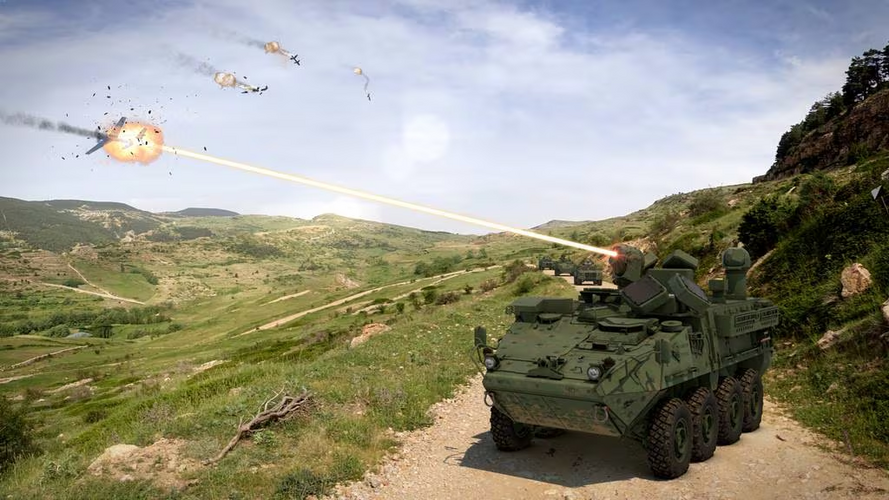- Joined
- 3 June 2011
- Messages
- 18,331
- Reaction score
- 12,209
It's acceptable as a "solution we have in stock and in production right now." I'd want the replacement C-UAS missile to be faster. And if we use the aircraft or vehicle ATGM as that solution, that's fine as well. In fact, I'd really like for the vehicle ATGM to be capable of C-UAS in addition to any purpose-designed missiles for the job.
Not that spendy. Not like it's a Patriot or SM-6, or even an AIM-9X.Spendy though.

There's different arguments on both sides...Makes you wonder whether the Zumwalt was right to give up its 57mm guns.

Italian Destroyer Guns Down Houthi Drone With 76mm 'Super Rapid' Cannon
As part of the European Operation Aspides, Italy has become the fifth country to engage Houthi threats over the Red Sea.www.twz.com
If you have a guided 57mm round, that puts things down to a single round to down the target, but guided cannon rounds are expensive.
Effective engagement range is another interesting debate.
True, but it's still an order of magnitude more $$ than a dumb shell (or unguided with proximity fuze).DARTs are radio command guided, which is probably the cheapest form of guidance.





In what direction does that work in though. My reading of it was that it only works in terms of the sound the operator hears, not the external noise on location.They will get quieter

Advanced noise suppression technology for improved search and rescue drones
Unmanned Aerial Vehicles (UAVs) have received significant attention in recent years across many sectors, such as military, agriculture, construction, and disaster management. These versatile machines offer remote access to hard-to-get or hazardous areas and excellent surveillance capabilities.techxplore.com
The Answer is simple, since most are subsonic a 20 or 30mm cannon should do.Current drones are small and cheap. killing them needs expensive weapons designed to shoot down planes and missiles.

Net guns were one of the first counter-drone technologies, no need for two drones.How about a drone that splits into two drones extending a huge net as it does so?

 dronecatcher.nl
dronecatcher.nl
View: https://x.com/astraiaintel/status/1766794520430010757?s=20
British Army Paratroopers Get Computerized Rifle Sights To Shoot Down Drones
The British Army fielding SMASH X4 computerized gun sights highlights the need for layers of drone defenses among armed forces worldwide.www.twz.com
Seems to be a modern version of the WWII gyro sights, sight tracks the drone and generates an offset firing cue, taking the art out of guessing the lead.
My idea was to extend a very large net though.Net guns were one of the first counter-drone technologies, no need for two drones.
And they already went airborne:

DroneCatcher, Controlled drone Interception
DroneCatcher is a multicopter that counters unwanted drones in a controlled and safe manner. Targets can be towed to safety and/or dropped with a parachute.dronecatcher.nl
Seems to me a high-speed, high-maneuverability "racing drone" that's able to shoot out strings would do the job. Get in front of or above the target, spew out some Spiderman webbing, watch it tangle the targets props and fall from the sky, repeat. Should be *cheap.*How about a drone that splits into two drones extending a huge net as it does so?
I've always thought it was a dumb idea. The guns they replaced them with. . .well, they speak for themselves:Makes you wonder whether the Zumwalt was right to give up its 57mm guns.

Italian Destroyer Guns Down Houthi Drone With 76mm 'Super Rapid' Cannon
As part of the European Operation Aspides, Italy has become the fifth country to engage Houthi threats over the Red Sea.www.twz.com
View: https://x.com/alessionaval/status/1764213187929424294?s=20
For comparison:I've always thought it was a dumb idea. The guns they replaced them with. . .well, they speak for themselves:
Shotguns are very limited in range, only 30-50 yards max.I see a lot of soldiers trying to shoot these things down and maybe we're missing a trick here. There's been a type of gun designed for shooting small flying objects around for a long time.
That may be enough to defend against a direct attack. Certainly a better probability of success than firing an AR and then throwing it at the drone.Shotguns are very limited in range, only 30-50 yards max.

Maybe also with proxity-fused air-bursting frag-12 rounds.
Appears someone was listening, just the wrong one.I see a lot of soldiers trying to shoot these things down and maybe we're missing a trick here. There's been a type of gun designed for shooting small flying objects around for a long time.
View attachment 722796
View: https://www.youtube.com/watch?v=vh3Z7OeWldI
Multitube shotgun seems like a pretty simple solution
A crashing drone is a hazard too TBH. I actually saw a Russian drone that uses a net to catch the other drone and fly away with it. For Olympic purposes, that would probably be safest.The Olympic/Paralympic scenario does raise the question about which counter-drone technologies can safely be used in a civilian environment. No kinetic solutions, no jammers, no high-energy / microwave weapons ....


Right now, his office is evaluating 10-, 20-, 50- and 300-kilowatt options for a wide variety of threats and missions. The 300-kilowatt laser is designed for the Indirect Fire Protection Capability, which is a system that will use kinetic, laser and high-powered microwave weapons to destroy threats including rockets, artillery, mortars, drones and cruise missiles. The Army is to receive that laser weapon next year.
Jammers will annoy everyone trying to connect via wifi (blocking a lot of wifi signals).The Olympic/Paralympic scenario does raise the question about which counter-drone technologies can safely be used in a civilian environment. No kinetic solutions, no jammers, no high-energy / microwave weapons ....
